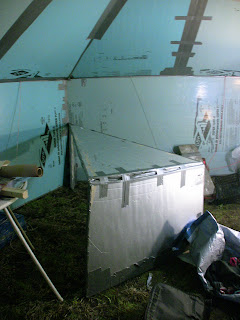
This table was made out of an extra triangle of insulation board. There is a wood support in the middle. It cannot hold much weight, but is a great design for the interior of the yurt because it maximizes table space without obscuring the wall space which will be covered shortly in drawings, typed posters of the future scenario, and image collages/montages.

These are developing Lion's Main mushrooms. THe moisture kept in the yurt creates an ideal growing condition for mushrooms. Once the first generation of mushrooms is harvested, the mycelium left in the bag will be used to remove toxins from soil used in the terrariums. What I am describing is a potentially closed-loop system of maintaining a toxin-free home environment. The worm compost creates soil which is treated by the mycelium (which produce consumeable mushrooms for food), the rainwater is collected in gutters made out of plastic-lined cardboard edges I salvaged from dumpsters that were once used as a packing material for photocopy machines, the rainwater is treated and detoxified by the aquatic and wetland plants, the water in turn is used on the mushrooms and terrarium plants, and the plant terrariums feed on this remediated soil and water---a process that perpetually and sustainably filter toxins out of the air. All of these steps are important parts of the environmental maintanance systems that improve environmental and human health today and are necessary for survival in the scenario for 2150.




No comments:
Post a Comment